
The silver Y is a migratory moth of the family Noctuidae which is named for the silvery Y-shaped mark on each of its forewings.
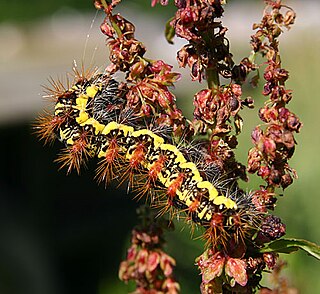
Acronicta oblinita, the smeared dagger moth or arioch dagger, is a moth of the family Noctuidae. Its larva, the smartweed caterpillar, has urticating hairs. The species was first described by James Edward Smith in 1797.
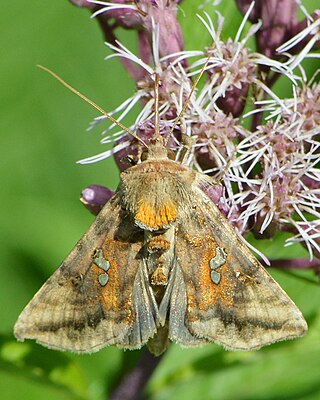
Autographa bimaculata, the two-spotted looper moth, twin gold spot or double-spotted spangle, is a moth of the family Noctuidae. The species was first described by James Francis Stephens in 1830. It is found in North America from Newfoundland west, just short of the coast of British Columbia, north to the Northwest Territories and south to New Mexico in the west and Pennsylvania and Long Island in the east.
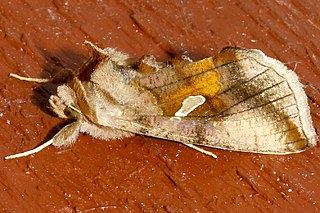
Autographa metallica, the shaded gold spot, is a moth of the family Noctuidae. The species was first described by Augustus Radcliffe Grote in 1875. It is found in western North America from the southern Alaska coast and the Queen Charlotte and Vancouver Islands south to central California, east to the Alberta-British Columbia border and south in the Rocky Mountains to central Colorado.
Hypocoena basistriga is a species of moth of the family Noctuidae first described by James Halliday McDunnough in 1933. It is found from Newfoundland and Labrador west to British Columbia and Yukon. This species of moth is found to frequent mesic areas including the edges of aspen bluffs and hayfields, old fields, meadows, etc.

Apamea zeta is a moth of the family Noctuidae. It has a Holarctic distribution, and can be found throughout the Northern Hemisphere. It occurs throughout Europe and the northern half of North America.

Aseptis characta is a moth of the family Noctuidae first described by Augustus Radcliffe Grote in 1880. It is widespread in western North America, where it is found in the western Great Plains, Great Basin, and Pacific regions from British Columbia, Alberta, and Saskatchewan to Colorado, Utah, northern Arizona and southern California. The species occurs in dry habitats like sagebrush steppe, juniper woodlands, and open forest from sea level to 2,500 meters.

Idia americalis, the American idia or American snout, is a litter moth of the family Erebidae. The species was first described by Achille Guenée in 1854. It is commonly found in moist forests in North America, ranging from southern Canada to Florida and Texas. It is nocturnal and can be lured by sugar baits and light traps.
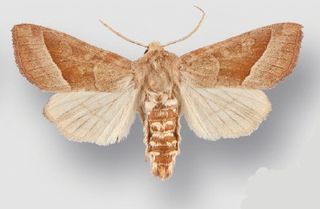
Hydraecia obliqua is a moth in the family Noctuidae first described by Leon F. Harvey in 1876. It is found in western North America, east to the Sierra Nevada in California and the crest of the Cascade Range in Oregon and Washington. It occurs continuously on the coast north to south-western British Columbia, with a disjunct northern population at Terrace, British Columbia. The habitat consists of the riparian zone along creeks and rivers of coastal rainforests, as well as oak savanna, mixed hardwood forests and valley grasslands.

Hydraecia medialis is a moth in the family Noctuidae. It is found in western North America. East of the Cascades, it occurs as far north as the Cariboo region in south-central British Columbia. The range extends across the Rocky Mountains in Montana and then spreads north and south on the Great Plains to reach Alberta, the western Dakotas and northern New Mexico. The habitat consists of open ponderosa pine forests, drier sagebrush steppe and juniper woodlands.

Fishia yosemitae, the dark grey fishia or grey fishia, is a moth in the family Noctuidae. It is found from central Alberta to Colorado in the Rocky Mountain and Great Plains regions. It is also found in eastern, central, and southern California, as well as in the Intermountain region. The habitat consists of dry open areas, including open ponderosa pine forests, juniper woodlands and sagebrush steppe at low to middle elevations.

Manulea bicolor, the bicolored moth or yellow-edged footman, is a moth of the family Erebidae. It is found in boreal North America, from Labrador and Massachusetts to Yukon and British Columbia. In the Rocky Mountains, it ranges south to southern Colorado. The habitat consists of boreal forests, parklands and riparian cottonwoods in the prairies.
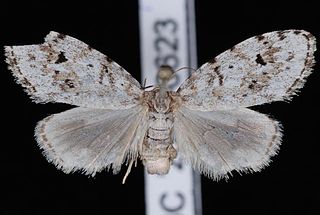
Clemensia albata, the little white lichen moth, is a moth of the family Erebidae. It was described by Alpheus Spring Packard in 1864. It is found in eastern North America, west across boreal Canada to south-eastern British Columbia. The range extends along the Pacific Coast south to Monterey Bay in west-central California. The habitat consists of moist forests, including coastal rainforests, oak woodlands and mixed hardwood forests.

Apantesis virguncula, the little virgin tiger moth, is a moth of the family Erebidae. It was described by W. Kirby in 1837. It is found across most of southern Canada and the United States, from the Rocky Mountains eastward. In the north, the range extends to northern Alberta and Newfoundland. In the south, it occurs along the Rocky Mountain to Apache County in Arizona and New Jersey in the east. It occurs in a variety of open wooded habitats, ranging from marshes, fens and bogs to transition parkland and prairie.
Arctia yarrowii, or Yarrow's tiger moth, is a moth of the family Erebidae. It was described by Richard Harper Stretch in 1874. It is found in North America from Hudson Bay to British Columbia and northern Arizona. The habitat consists of barren rocky fellfields and slides above the timberline. These moths are also found in the Pacific Northwest.
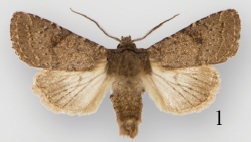
Protorthodes curtica is a moth in the family Noctuidae first described by Smith in 1890. It is found in North America from the interior of southern British Columbia southward in the West Coast states, mainly to the east of the Cascades and Coastal ranges, to southern California. It occurs in the Rocky Mountains in Idaho and Montana and in the Ruby Mountains of Nevada. The habitat consists of dry forested areas.

Orthosia hibisci, the speckled green fruitworm moth, is a moth of the family Noctuidae. It is found in most of North America, except in desert regions. The habitat consists of moist forests, riparian, agricultural and urban areas.

Plagiomimicus spumosum, the frothy moth, is a moth of the family Noctuidae. The species was first described by Augustus Radcliffe Grote in 1874. It is found in North America, where it has a transcontinental range in the United States, north to southern Ontario and southern Alberta.

Proxenus miranda, the miranda moth or glistening rustic, is a moth of the family Noctuidae. It is found in most of North America, where it has been recorded south through California to Arizona and in the Rocky Mountains to Colorado in the west. In the east it is found from southern Canada to South Carolina, Tennessee and Texas. The habitat consists of moist, open forests and grasslands.

Pseudeustrotia carneola, the pink-barred lithacodia moth, is a moth of the family Noctuidae. The species was first described by Achille Guenée in 1852. It is found in North America, where it has been recorded from Nova Scotia and New Brunswick west to Alberta and Colorado, south to the Gulf of Mexico. The habitat consists of woodland edges, mesic meadows and grasslands regions.


















